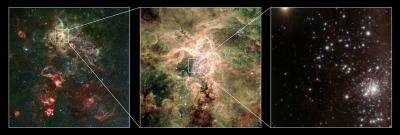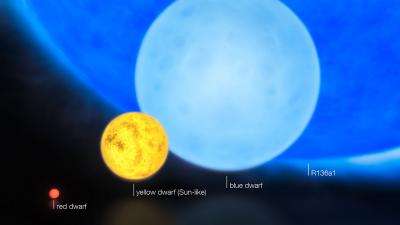300 solar masses: Scientists find most massive star ever discovered (w/ Video)

(PhysOrg.com) -- Using a combination of instruments on ESO's Very Large Telescope, astronomers have discovered the most massive stars to date, one weighing at birth more than 300 times the mass of the sun, or twice as much as the currently accepted limit of 150 solar masses. The existence of these monsters -- millions of times more luminous than the sun, losing weight through very powerful winds -- may provide an answer to the question, "how massive can stars be?"
A team of astronomers led by Paul Crowther, Professor of Astrophysics at the University of Sheffield, has used ESO's Very Large Telescope (VLT), as well as archival data from the NASA/ESA Hubble Space Telescope, to study two young clusters of stars, NGC 3603 and RMC 136a in detail. NGC 3603 is a cosmic factory where stars form frantically from the nebula's extended clouds of gas and dust, located 22 000 light-years away from the Sun. RMC 136a (more often known as R136) is another cluster of young, massive and hot stars, which is located inside the Tarantula Nebula, in one of our neighbouring galaxies, the Large Magellanic Cloud, 165 000 light-years away.
The team found several stars with surface temperatures over 40 000 degrees, more than seven times hotter than our Sun, and a few tens of times larger and several million times brighter. Comparisons with models imply that several of these stars were born with masses in excess of 150 solar masses. The star R136a1, found in the R136 cluster, is the most massive star ever found, with a current mass of about 265 solar masses and with a birthweight of as much as 320 times that of the Sun.
In NGC 3603, the astronomers could also directly measure the masses of two stars that belong to a double star system, as a validation of the models used. The stars A1, B and C in this cluster have estimated masses at birth above or close to 150 solar masses.
Very massive stars produce very powerful outflows. "Unlike humans, these stars are born heavy and lose weight as they age," says Paul Crowther. "Being a little over a million years old, the most extreme star R136a1 is already 'middle-aged' and has undergone an intense weight loss programme, shedding a fifth of its initial mass over that time, or more than fifty solar masses."
If R136a1 replaced the Sun in our Solar System, it would outshine the Sun by as much as the Sun currently outshines the full Moon. "Its high mass would reduce the length of the Earth's year to three weeks, and it would bathe the Earth in incredibly intense ultraviolet radiation, rendering life on our planet impossible," says Raphael Hirschi from Keele University, who belongs to the team.
These super heavyweight stars are extremely rare, forming solely within the densest star clusters. Distinguishing the individual stars — which has now been achieved for the first time — requires the exquisite resolving power of the VLT's infrared instruments.
The team also estimated the maximum possible mass for the stars within these clusters and the relative number of the most massive ones. "The smallest stars are limited to more than about eighty times more than Jupiter, below which they are 'failed stars' or brown dwarfs," says team member Olivier Schnurr from the Astrophysikalisches Institut Potsdam. "Our new finding supports the previous view that there is also an upper limit to how big stars can get, although it raises the limit by a factor of two, to about 300 solar masses."
Within R136, only four stars weighed more than 150 solar masses at birth, yet they account for nearly half of the wind and radiation power of the entire cluster, comprising approximately 100 000 stars in total. R136a1 alone energises its surroundings by more than a factor of fifty compared to the Orion Nebula cluster, the closest region of massive star formation to Earth.

Understanding how high mass stars form is puzzling enough, due to their very short lives and powerful winds, so that the identification of such extreme cases as R136a1 raises the challenge to theorists still further. "Either they were born so big or smaller stars merged together to produce them," explains Crowther.
Stars between about 8 and 150 solar masses explode at the end of their short lives as supernovae, leaving behind exotic remnants, either neutron stars or black holes. Having now established the existence of stars weighing between 150 and 300 solar masses, the astronomers' findings raise the prospect of the existence of exceptionally bright, "pair instability supernovae" that completely blow themselves apart, failing to leave behind any remnant and dispersing up to ten solar masses of iron into their surroundings. A few candidates for such explosions have already been proposed in recent years.
Not only is R136a1 the most massive star ever found, but it also has the highest luminosity too, close to 10 million times greater than the Sun. "Owing to the rarity of these monsters, I think it is unlikely that this new record will be broken any time soon," concludes Crowther.
• PhysOrg.com iPhone / iPad Apps
• PhysOrg.com Audio Podcasts / iTunes
• PhysOrg.com Android apps (new version available)
• Join PhysOrg.com on Facebook!
• Follow PhysOrg.com on Twitter!
More information:
This work is presented in an article published in the Monthly Notices of the Royal Astronomical Society (“The R136 star cluster hosts several stars whose individual masses greatly exceed the accepted 150 Msun stellar mass limit”, by P. Crowther et al.).
www.eso.org/public/archives/re … /eso1030/eso1030.pdf
Provided by ESO



















